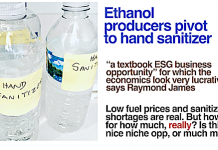Jim Lane
 The results from Gevo’s (GEVO) 4th quarter are in, and a worth a look-see, not only for fans of isobutanol and its prospects.
The results from Gevo’s (GEVO) 4th quarter are in, and a worth a look-see, not only for fans of isobutanol and its prospects.
Also for a look at how this member of the 2010-12 IPO group of companies is crossing the multiple Valleys of Death that have arrayed before it.
In the fourth quarter of 2014, Gevo continued to progress the commercial operation of isobutanol at Luverne under the Side-by-Side mode of production (SBS), meeting its stated milestone in December 2014 of producing greater than 50K gallons of isobutanol in one month. This achievement, Gevo notes, “was a result of the introduction of Gevo’s second-generation yeast biocatalyst at the plant, as well as significant process improvements learned by Gevo since switching the plant to SBS production earlier in 2014.”
The good news there is well highlighted by Gevo. We’ll note that, ultimately, the Luverne facility has a 15 million gallon or so theoretucal capacity for isobutanol, based on the guidance we’ve had from experts over the years. Right now, one production train out of four is engaged in isobutanol, so the company could be producing at a 200K gallon/month rate, or 2.4M gallons per year. So. there’s a ways to go.
Where do you get in the end?
Gevo says: “The data generated at the Luverne plant and in the labs in Denver continues to support ultimate, optimized isobutanol production costs that would support EBITDA margins for isobutanol of $0.50-$1.00 per gallon. In the fourth quarter, Praj Industries, a global leader in process engineering and equipment manufacturing for the ethanol and brewing industries, conducted extensive due diligence at the Luverne plant, and has confirmed these cost projections.”
And it’s worth noting that Praj subsequently signed a memorandum of understanding (MOU) wherein Praj will undertake to license up to 250 million gallons of isobutanol capacity for sugar-based ethanol plants over the next ten years so, that’s a pretty strong affirmative although 10 years could be read as “not tomorrow, bub.”
The licensing expands
After a long couple of years of optimization, Gevo’s focus has turned decisively towards licensing. In addition to the Praj MOU, Gevo signed a letter of intent (LOI) in the fourth quarter to license its technology to Highland EnviroFuels’ sugar cane and sweet sorghum project based in Florida. These supplement the LOIs that were previously entered into with IGPC Ethanol Inc.based in Canada, and Porta Hnos S.A. based in Argentina.
What’s the conversion rate of LOIs and MOUs into actual biding agreements that will be inked in 2015. Gevo says it is is targeting “at least one licensee” this year.
Expanding partner set, especially in fuels
In Q4, Gevo highlighted partenrships with Brenntag Canada, who began sales of isobutanol to the specialty chemical markets, and Gulf Racing Fuels who have introduced isobutanol for use in off-road applications, including sales to retail consumers through NAPA Auto Parts in North Dakota.
The testing was performed in collaboration with the National Marine Manufacturers Association, the American Boat and Yacht Council and several engine and boat manufacturers across the industry, and was also supported by The US Department of Energy, the Office of Energy Efficiency and Renewable Energy and Argonne National Laboratory.
Expanding product set
Gevo announced the introduction of a new technology it has developed to convert ethanol into a tailored mix of end-products, including propylene and renewable hydrogen. “Preliminary technical and economic analyses indicate that the products, sourced from renewable feedstock, would be cost competitive with traditional petrochemical approaches,” we
Partnership we didn’t hear as much about
The Coca-Cola partnership, subject of a paraxylene pilot in Texas nary a reference to Coca-Cola in the latest word from Camp Gevo.
Certifications
You can’t sell a fuel if it’s not registered and certified. How’s it going there? “Gevo anticipates achieving both ASTM and MIL-SPEC certifications for its jet fuel in 2015,” which it says “would help accelerate the commercial adoption of Gevo’s product in both the commercial and military jet markets,” and there’s no disagreement there, although any expectations on specific volumes and timings for those segments should be marked “speculative grade” for the moment.
Plus, a consortium of “leading organizations from the recreational marine industry” announced the completion of more than four years of testing of Gevo’s isobutanol for use in boat engines, and gave isobutanol a thumbs-up.
Capital calls
Speaking of “gas in the tank” how much does Gevo have?
The company “Ended the fourth quarter with cash and cash equivalents of $6.4 million,” had Q4 revenues of “as compared to $1.7 million for Q4 2013. No doubt there are going to have to be more debt-raising or equity-raising activities, and relatively soon, with a net loss of $11M for Q4.
“The conversion of alcohols to hydrocarbons is also generating significant interest from potential strategic investors,” noted Gevo CEO, Pat Gruber, perhaps tipping the direction the company will take for capital raising. “The ability to produce cost competitive renewable propylene, which is used in a multitude of consumer products, as well as renewable hydrogen, have been “holy grails” of the bio-based economy. We believe that we have an effective proprietary technology to do this based on feedback from partners and potential strategic investors.” he added.
Jeffrey Osborne at Cowen & Co writes: “Gevo’s revenue ramp continued in 4Q14, bolstered by Side-by-Side operations at the Luverne facility. Management focused on ethanol production at the plant to generate additional cash. Isobutanol production continues on a limited basis to support and seed customer demand as well as validate the technology. Looking forward, Isobutanol licensing could be an important revenue stream for Gevo.”
Osborne also noted that “Ethanol production at the Luverne facility is generating the cash flows necessary to support the business as isobutanol continues to mature… [and] the isobutanol produced at the Luverne facility helps not only to meet existing customer demand, but also increases the products visibility and seeds new markets.”
Three good items in Gevo’s favor, in Osborne’s analysis. An enterprise value of $62M vs market cap of $37M, suggesting that Gevo is substantially undervalued. Net debt is shown at zero. and short interest at a not-so-high 6.5%.
The final word
We’ll give the final word to Praj CEO Prahmod Chaudhari, who says:
“Praj has conducted significant diligence on Gevo’s corn starch-based isobutanol technology and we believe in the technology. Isobutanol has a substantial market opportunity given that isobutanol is a high performance biofuel that can solve many of the issues of 1st generation biofuels. It also enables a true biorefinery model wherein a number of specialty chemicals and bio-products can be produced using isobutanol as a feedstock. We look forward to creating a new opportunity for 1st generation sugar-based ethanol plant owners, as well as accelerating the use of 2nd generation cellulosic feedstocks to produce isobutanol.”
Jim Lane is editor and publisher of Biofuel
s Digest where this article was originally published. Biofuels Digest is the most widely read Biofuels daily read by 14,000+ organizations. Subscribe here.








